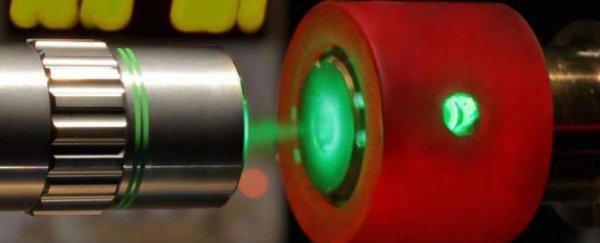By subjecting hydrogen molecules to record pressures more than 3 million times that of Earth's atmosphere, physicists in the UK have achieved the early stages of a never-before-seen hydrogen phase, known as Phase V.
Observations of the chemical bonds that make up the resulting material suggest the possible appearance of a metallic form of hydrogen - something that was predicted back in 1935, but had failed to be convincingly recreated in the lab. It's thought that this elusive hydrogen metal can conduct electricity with no resistance, and exists in large amounts inside Jupiter and Saturn.
"The past 30 years of the high-pressure research saw numerous claims of the creation of metallic hydrogen in the laboratory, but all these claims were later disproved," says lead researcher, Eugene Gregoryanz from the University of Edinburgh. "Our study presents the first experimental evidence that hydrogen could behave as predicted, although at much higher pressures than previously thought. The finding will help to advance the fundamental and planetary sciences."
Gregoryanz and his team used diamond anvils in a room-temperature environment to apply a mind-bending pressure of over 380 GigaPascals to hydrogen molecules. To put that in perspective, 1 GigaPascal is equivalent to around 10,000 Earth atmospheres of pressure. Not only is this the highest pressure scientists have applied to hydrogen molecules, it's also one of the highest pressures that's ever been achieved in a lab.
This incredibly high pressure appeared to change the chemical bonds in the hydrogen molecules, causing them to enter a new solid phase - Phase V. At this point, the molecules started acting really weird, as they began to separate into single atoms with electrons that started to behave more like those of a metal, rather than a gas.
John Timmer explains at Ars Technica:
"Normally, hydrogen comes in a molecular form, with two atoms sharing their electrons. This bond keeps the electrons from circulating freely and determines many of the molecule's properties. These properties include things like the wavelengths of light it absorbs as the electrons change their energy levels or the bond between them stretches. Making a metal involves dissolving that bond and therefore changing the properties."
Publishing in Nature today, the team says that while they haven't achieved a fully metallic state of hydrogen, they've observed the early stages - "the onset of the predicted non-molecular and metallic state of hydrogen". This provides evidence to suggest that even higher pressures could achieve the purely metallic state that's been predicted by theory - but diamond anvils might not be enough.
The study is likely to be met by criticism, as have been all other claims to achieving metallic hydrogen in the lab previously. Back in 2012, researchers in Germany said they'd found evidence of a metallic state, but as Ivan Amato reported for Nature at the time, the problem with these kinds of experiments is diamond anvils can only use "vanishingly small sample sizes", and "high-pressure experiments are fraught with the potential for error".
"Hydrogen is the simplest atom, the simplest molecule, and perhaps the most complicated elemental solid," Arthur Ruoff, a high-pressure physicist at Cornell University, told Amato.
We'll just have to wait and see what the critics have to say about this latest attempt, and meanwhile, the next challenge for physicists will be to find something that can apply even more pressure than diamonds.
 Artistic representation of a hydrogen molecule under compression using opposed diamond anvils. Credit: Philip Dalladay-Simpson and Eugene Gregoryanz
Artistic representation of a hydrogen molecule under compression using opposed diamond anvils. Credit: Philip Dalladay-Simpson and Eugene Gregoryanz
